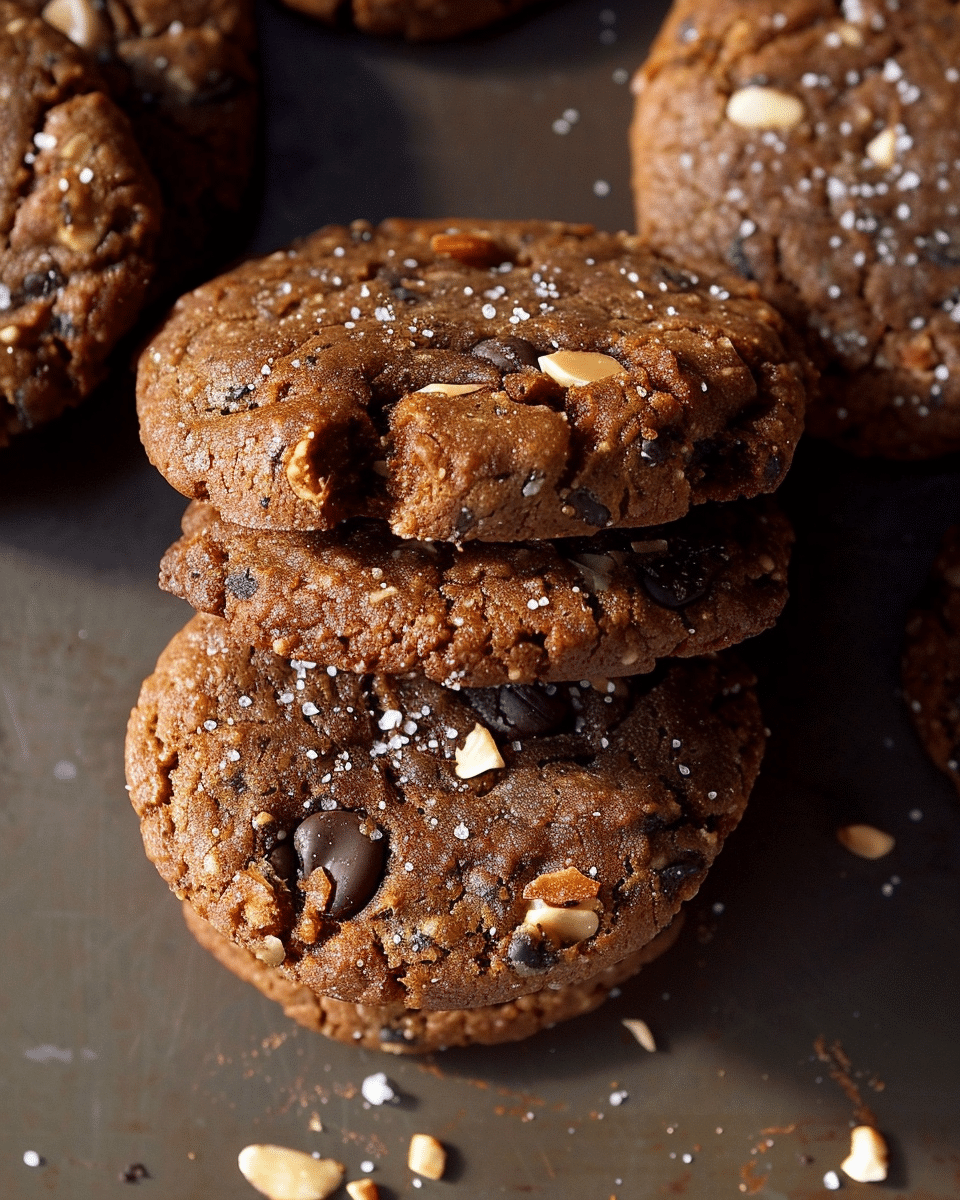These soft and chewy almond pulp cookies are the perfect solution to using leftover almond pulp from homemade almond milk. With natural sweetness from honey or maple syrup and a delightful texture from coconut flour, these nutritious treats prove that healthy cookies can be absolutely delicious.

Why You'll Love This Recipe
These almond pulp cookies are a sustainable baker's dream, transforming what would typically be discarded into a delightful treat. They're naturally sweetened, grain-free, and packed with nutritious ingredients. The cookies offer a soft, chewy texture with customizable mix-ins like chocolate chips or chopped nuts. Whether you're following a specific dietary plan (paleo, gluten-free, or dairy-free) or simply looking for a healthier cookie option, this recipe delivers on both taste and nutrition. Plus, they're incredibly simple to prepare, taking just minutes to mix together before baking.
Ingredients
(Tip: You'll find the full list of ingredients and measurements in the recipe card below.)
Almond pulp is the star of this recipe, giving these cookies their unique texture while utilizing a byproduct of homemade almond milk. The wet, fibrous pulp adds moisture and a subtle almond flavor that forms the foundation of these treats.
Almond flour enhances the nutty flavor profile while improving the structure of the cookies. It works alongside the almond pulp to create a tender crumb without the need for conventional flour.
Honey or maple syrup provides natural sweetness without refined sugar. Both options work equally well, with honey offering a more distinct flavor and maple syrup providing a milder, caramel-like sweetness.
Coconut flour is highly absorbent and helps bind the cookies together. It contributes a subtle coconut undertone that complements the almond flavors beautifully.
Coconut oil adds necessary fat for a good cookie texture while keeping these treats dairy-free. When melted, it integrates perfectly with the other ingredients and solidifies upon cooling to help hold everything together.
Vanilla extract brings warmth and depth to the flavor profile, enhancing both the nutty and sweet elements of the cookies.
Baking soda provides the perfect amount of leavening to keep these cookies from being too dense. Just a small amount helps them spread slightly and maintain a pleasant texture.
Salt balances the sweetness and enhances all the flavors. Even in small amounts, it's crucial for a well-rounded taste.
Dark chocolate chips are an optional but delicious addition, adding pockets of rich chocolate flavor that contrast beautifully with the nutty base. Choose dairy-free varieties if maintaining a vegan recipe.
Chopped nuts add textural contrast and additional nutrients. Consider walnuts, pecans, or additional chopped almonds to complement the existing flavors.
Directions
- Preheat your oven to 350°F (175°C). Line a baking sheet with parchment paper or a silicone baking mat.
- In a large mixing bowl, combine the almond pulp, almond flour, coconut flour, baking soda, and salt.
- In a separate bowl, whisk together the melted coconut oil, honey or maple syrup, and vanilla extract.
- Pour the wet ingredients into the dry ingredients and mix until fully combined. If the dough feels too wet, add more coconut flour a tablespoon at a time.
- Fold in the chocolate chips and chopped nuts if using.
- Scoop tablespoon-sized portions of the dough onto the prepared baking sheet, spacing them about 2 inches apart. Gently flatten each cookie with the back of a spoon.
- Bake for 10-12 minutes, or until the edges are golden brown.
- Let the cookies cool on the baking sheet for 5 minutes before transferring to a wire rack to cool completely.
Servings and Timing
This recipe yields approximately 12 cookies. The preparation takes just 10 minutes, while baking requires 12 minutes, making the total time around 22 minutes. Each cookie contains approximately 120 calories, making them a reasonable treat that won't derail your healthy eating habits. These cookies are perfect for a quick snack, post-workout refuel, or a healthier dessert option that satisfies sweet cravings while providing nutritional benefits.
Variations
Chocolate Dipped: Once cooled, dip half of each cookie in melted dark chocolate for an elegant and indulgent touch.
Spiced: Add 1 teaspoon of cinnamon and a pinch of nutmeg to the dry ingredients for warming spice cookies perfect for fall or winter.
Lemon Poppy Seed: Add 1 tablespoon of lemon zest and 1 tablespoon of poppy seeds for a bright, citrusy version.
Trail Mix: Incorporate dried cranberries, pumpkin seeds, and a variety of chopped nuts for a trail mix-inspired cookie.
Coconut: Add ¼ cup of unsweetened shredded coconut to the dough for enhanced coconut flavor and texture.
Protein-Boosted: Mix in 2 tablespoons of your favorite unflavored or vanilla protein powder to make these cookies more filling and protein-rich.
Chocolate Chunk Walnut: Use large chunks of dark chocolate and toasted walnuts for a more rustic, bakery-style cookie.
Storage/Reheating
Counter Storage: Store cooled cookies in an airtight container at room temperature for up to 3 days. Place parchment paper between layers to prevent sticking.
Refrigerator Storage: For longer freshness, refrigerate the cookies in an airtight container for up to 1 week. The cold environment will make them firmer, so you may want to let them come to room temperature before enjoying.
Freezer Storage: These cookies freeze exceptionally well. Place them in a single layer on a baking sheet until frozen solid, then transfer to a freezer-safe container or bag. They will keep for up to 3 months. Separate layers with parchment paper to prevent sticking.
Reheating: For that fresh-baked taste, warm refrigerated or frozen cookies in a 300°F (150°C) oven for 3-5 minutes. Alternatively, microwave individual cookies for 10-15 seconds to soften them slightly. Frozen cookies can be thawed at room temperature for about 30 minutes before enjoying.
Dough Storage: The cookie dough can be refrigerated for up to 3 days or frozen for up to 1 month. If frozen, thaw in the refrigerator overnight before baking. You may need to add a minute or two to the baking time when baking from refrigerated dough.

FAQs
What is almond pulp and how do I get it?
Almond pulp is the fibrous material left over after making homemade almond milk. To obtain it, soak almonds overnight, blend them with fresh water, and strain through a nut milk bag or fine cheesecloth. The liquid is your almond milk, and the remaining solids are the almond pulp.
Can I use store-bought almond milk residue?
Store-bought almond milk doesn't produce pulp since it's already processed. This recipe specifically uses the leftover pulp from making homemade almond milk.
How wet should the almond pulp be for this recipe?
The almond pulp should be somewhat damp but not dripping wet. After making almond milk, lightly squeeze excess moisture from the pulp. If it feels very wet, spread it on a clean kitchen towel and press gently to remove some moisture.
Can I substitute the almond flour with something else?
Yes, you can use oat flour or all-purpose flour as substitutes, though this will change the texture and nutritional profile. For gluten-free options, a 1:1 gluten-free flour blend can work well.
Is there a substitute for coconut flour?
Coconut flour is uniquely absorbent and difficult to substitute directly. If needed, try using additional almond flour, but you'll need about 3 times as much since coconut flour is so absorbent.
Can I make these cookies vegan?
Absolutely! Simply use maple syrup instead of honey, and ensure your chocolate chips are dairy-free.
How do I know when the cookies are done baking?
The cookies are done when the edges turn light golden brown and the tops appear set. They will still be somewhat soft in the center but will firm up as they cool.
Why did my cookies spread too much during baking?
If your cookies spread excessively, your almond pulp might have been too wet. Next time, drain it more thoroughly or add an extra tablespoon of coconut flour to the dough.
Can I reduce the sweetener for a less sweet cookie?
Yes, you can reduce the honey or maple syrup to 2-3 tablespoons. The cookies will be less sweet but still hold together well.
How can I make these cookies crispier?
For crispier cookies, flatten them more before baking and extend the baking time by 2-3 minutes. You can also reduce the amount of almond pulp slightly to create a drier dough.
Conclusion
These Healthy Almond Pulp Cookies represent the perfect intersection of sustainability, nutrition, and indulgence. By transforming almond pulp—a byproduct that might otherwise be discarded—into delicious treats, you're practicing eco-friendly baking while creating something truly delightful. The natural ingredients provide balanced nutrition without sacrificing flavor, proving that healthy alternatives can be just as satisfying as traditional cookies.
Whether you're an experienced baker looking to reduce food waste or someone new to alternative baking, these cookies offer an accessible entry point to healthier desserts. Their versatility allows for countless variations to suit your taste preferences or dietary needs. Plus, their make-ahead friendly nature means you can always have a nutritious sweet treat on hand.
Next time you make homemade almond milk, remember that the journey doesn't end with the liquid—those humble almond remains can transform into these remarkable cookies that nourish both body and soul.

Healthy Almond Pulp Cookies
- Total Time: 22 minutes
- Yield: 12 cookies
- Diet: Vegan
Description
These almond pulp cookies are a great way to use leftover almond pulp from making almond milk. They're soft, chewy, and sweetened naturally with honey, making them a delicious and healthy treat for any time of the day.
Ingredients
½ cups almond pulp (leftover from making almond milk)
½ cup almond flour
¼ cup honey or maple syrup
¼ cup coconut flour
¼ cup coconut oil, melted
½ teaspoon vanilla extract
½ teaspoon baking soda
¼ teaspoon salt
¼ cup dark chocolate chips (optional)
¼ cup chopped nuts (optional)
Instructions
- Preheat your oven to 350°F (175°C). Line a baking sheet with parchment paper or a silicone baking mat.
- In a large mixing bowl, combine the almond pulp, almond flour, coconut flour, baking soda, and salt.
- In a separate bowl, whisk together the melted coconut oil, honey or maple syrup, and vanilla extract.
- Pour the wet ingredients into the dry ingredients and mix until fully combined. If the dough feels too wet, add more coconut flour a tablespoon at a time.
- Fold in the chocolate chips and chopped nuts if using.
- Scoop tablespoon-sized portions of the dough onto the prepared baking sheet, spacing them about 2 inches apart. Gently flatten each cookie with the back of a spoon.
- Bake for 10-12 minutes, or until the edges are golden brown.
- Let the cookies cool on the baking sheet for 5 minutes before transferring to a wire rack to cool completely.
Notes
- If the dough feels too wet, gradually add more coconut flour to adjust the consistency.
- Optional mix-ins like chocolate chips or nuts can be omitted or adjusted to taste.
- These cookies are great for using up leftover almond pulp from homemade almond milk and can be customized with additional flavors like cinnamon or nutmeg.
- Prep Time: 10 minutes
- Cook Time: 12 minutes
- Category: Dessert
- Method: Baking
- Cuisine: Plant-Based
Nutrition
- Serving Size: 1 cookie
- Calories: 120
- Sugar: 5g
- Sodium: 50mg
- Fat: 8g
- Saturated Fat: 4g
- Unsaturated Fat: 4g
- Trans Fat: 0g
- Carbohydrates: 8g
- Fiber: 2g
- Protein: 2g
- Cholesterol: 0mg





